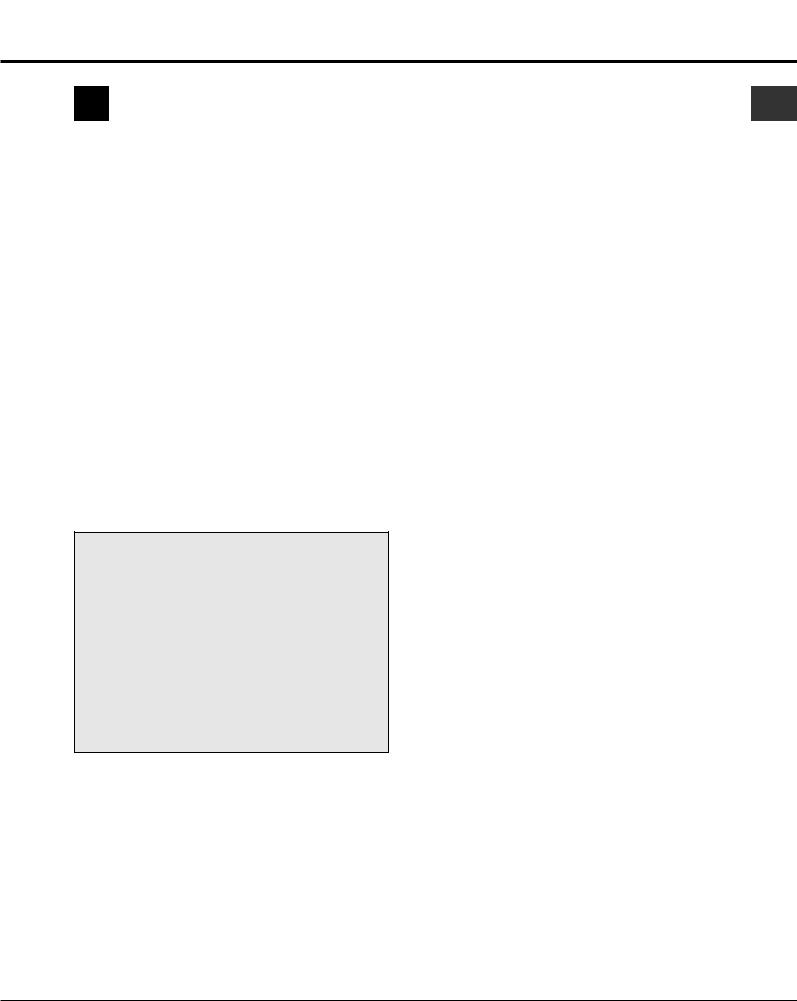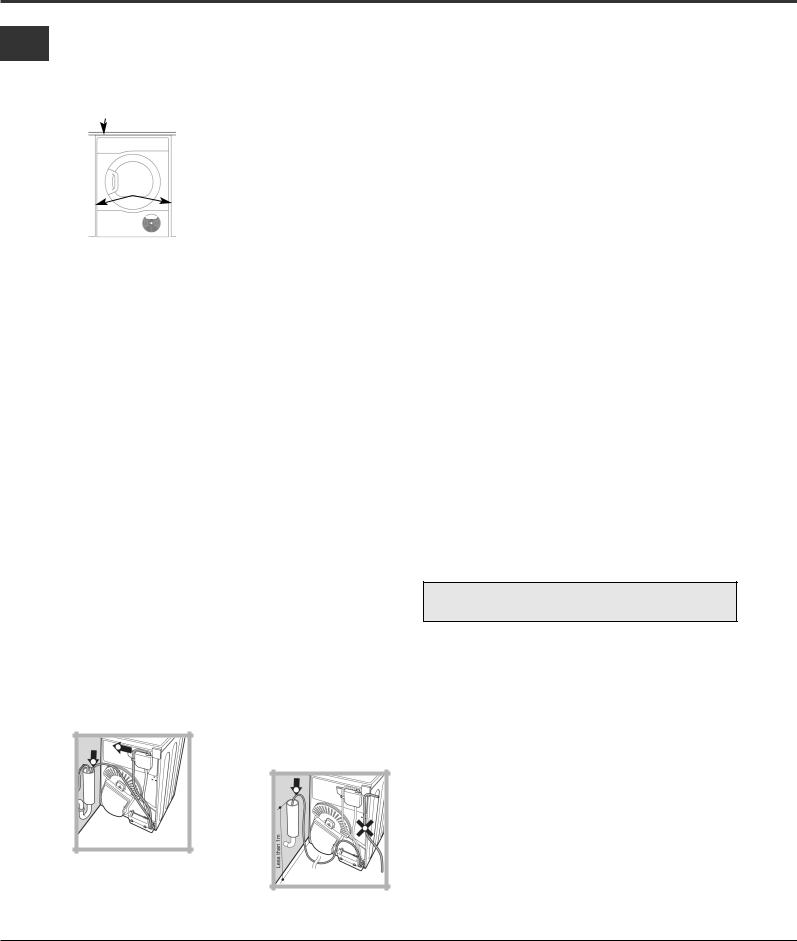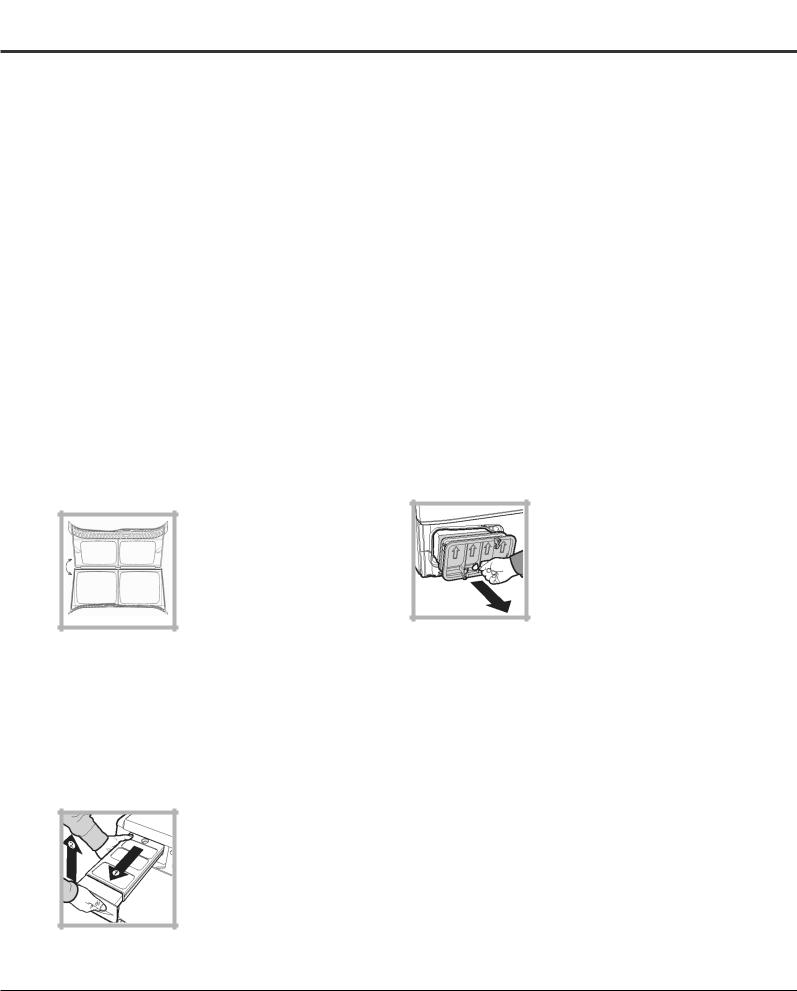HOTPOINT FTCF 87B GG (UK) User Manual

Instruction booklet
GB
English
FTCF 87B
TUMBLE DRYER
 This symbol reminds you to read this booklet.
This symbol reminds you to read this booklet.
!Keep this instruction booklet on hand in order to refer to it when necessary. Take it with you when you move, and should you sell this appliance or pass it on to another party, make sure that this booklet is supplied along with the dryer so that the new owner may be informed about warnings and suggestions on how the appliance works.
!Read these instructions carefully; the following pages contain important information on installation and suggestions on how the appliance works.
Contents |
GB |
|
Installation, 2
Where to put your dryer
Ventilation
Water drain
Electrical connection
Before you start using your dryer
Warnings, 3-4
General safety
To minimise the risk of fire
Maintenance and Care, 5-6
Switching off the electricity
Cleaning the filter after each cycle
Empty the water container after each cycle
Cleaning the condenser unit
Check the drum after each cycle
Cleaning the dryer
Dryer description, 7
The features
Control panel
Display, 8
Start and programmes, 9-13
The Controls
Programmes Table
The controls
Laundry, 14
Sorting your laundry
Wash care labels
Drying times
Troubleshooting, 15
Service, 16
Spare Parts
Recycling and Disposal
Product data, 17
To activate your free* 5 Year Parts Guarantee Call free on 0800 519 2102
*Labour charges not included. Terms and consitions apply. Lines open 364 days a year. Calls are free from a BT landline. Charges from other providers and mobiles may apply.
www.hotpoint.co.uk
1

Installation
Where to put your dryer
GB ● Place your dryer at a distance from gas ranges, stoves, heaters, or cook tops because flames can damage the appliance.
Minimum gap 10mm |
|
● If you are going to |
|
|
|
|
install the appliance |
|
|
|
|
|
|
|
|
|
|
|
under a work counter, |
|
|
|
be sure to leave a |
|
Minimum gaps |
10mm space between |
|
|
15mm |
the top and any other |
|
|
|
|
|
|
|
|
objects on or above |
|
|
|
the machine and a |
|
|
|
15mm space between |
|
|
|
|
the sides and lateral furnishings or walls. This is to ensure proper air circulation.
The appliance must be installed with the rear surface placed against a wall.
Ventilation
When the dryer is in use, there has to be adequate ventilation. Make sure you put your dryer in an environment that is not damp and has proper air circulation throughout. Airflow around the dryer is essential to condense the water produced during the washing, the dryer will not operate efficiently in an enclosed space or cupboard.
! If using the dryer in a small or cold room some
condensation could be experienced.
! We do not recommend that the dryer is installed in a cupboard but the dryer must never be installed behind a lockable door, a sliding door or a door with a hinge on the opposite side to that of the dryer door.
Water drain
If your dryer is installed next to a drain the water can be plumbed into this drain. This does away with the need to empty the water container. If the dryer is stacked onto or installed next to a washing machine it can share the same drain.
The height of the drain must be less than 3' (1m) from the bottom of the dryer.
Remove the existing hose from position shown in picture A.
picture A
Then fit a suitable length of hose to position shown in picture B.
! Make sure that the hose is not squashed or kinked when the dryer is in its final location.
Electrical connections
Make sure of the following before you insert the plug into the the electrical socket:
●Make sure your hands are dry.
●The socket must have an earth connection.
●The socket must be able to sustain the machines maximum power, which is indicated on the rating label (see Dryer Description).
●Power voltage must be within the values indicated on the rating label (see Dryer Description).
●The socket must be compatible with the dryers plug. Should this not be the case, replace the plug or the socket.
!The dryer must not be installed outdoors, even if the space is sheltered. It can be very dangerous if it is exposed to rain or storms.
!Once installed, the dryers electrical wire and plug must be within easy reach.
!Do not use extension cords.
!The power cord must not be bent or squashed.
!The power cord should be regularly checked. If the supply cord is damaged, it must be replaced by the manufacturer, its service agent or similarly qualified persons in order to avoid a hazard. New or longer power cords are supplied at an extra charge by authorised dealers.
!The manufacturer denies any responsibility should any of these rules not be followed.
!If in doubt about any of the above consult a qualified electrician.
Before you start using your dryer
Once you have installed your dryer and before you use it, clean the inside of the drum to remove any dust that could have accumulated during transport.
Maximum load
Natural fibres : 8 kg
2

Warnings
! The appliance has been designed and built according to international safety standards.
These warnings are given for safety reasons and must be followed carefully.
General safety
●This appliance can be used by children aged from 8 years and above and persons with reduced physical, sensory or mental capabilities, or lack of knowledge if they are given supervision or instruction concerning use of the appliance in a safe way and understand the hazards involved.
●This tumble dryer has been designed for home, and not professional use.
●Do not touch the appliance while bare foot or with wet hands or feet.
●Unplug the machine by pulling on the plug, not the cord.
●After using the dryer, turn it off and unplug it. Keep the door closed to make sure that children do not use it as a toy.
●Children should be supervised to ensure that they do not play with the dryer.
●Cleaning and user maintenance should not be made by children without supervision.
●Children of less than 3 years should be kept away from the appliance unless continuously supervised.
●The appliance must be installed correctly and have proper ventilation. The air intake at the front of the dryer should never be obstructed (see Installation).
●Never use the dryer on carpeting where the pile height would prevent air from entering the dryer from the base.
● Check to see if the dryer is empty before |
GB |
loading it. |
|
●The back of the dryer could become very hot. Never touch it while in use.
●Do not use the dryer unless the filter, water container and condenser are securely in place (see Maintenance).
●Do not overload the dryer (see Laundry for maximum loads).
●Do not load items that are dripping wet.
●Carefully check all instructions on clothing labels (see Laundry).
●Do not tumble dry large, very bulky items.
●Do not tumble dry acrylic fibres at high temperatures.
●Do not turn off the dryer when there are still warm items inside.
●Clean the filter after each use (see Maintenance).
●Empty the water container after each use (see Maintenance).
●Clean the condenser unit at regular intervals (see Maintenance).
●Do not allow lint to collect around the dryer.
●Never climb on top of the dryer. It could result in damage.
●Always follow electrical standards and requirements (see Installation).
●Always buy original spare parts and accessories (see Service).
3

Warnings
To minimise the risk of fire in your GB tumble dryer, the following should be
observed:
●Tumble dry items only if they have been washed with detergent and water, rinsed and been through the spin cycle. It is a fire hazard to dry items that HAVE NOT been washed with water.
●Do not dry garments that have been treated with chemical products.
●Do not tumble dry items that have been spotted or soaked with vegetable or cooking oils, this constitutes a fire hazard. Oil-affected items can ignite spontaneously, especially when exposed to heat sources such as a tumble dryer. The items become warm, causing an oxidisation reaction with the oil, Oxidisation creates heat. If the heat cannot escape, items can become hot enough to catch fire. Piling, stacking or storing oil-effected items can prevent heat from escaping and so create a fire hazard. If it is unavoidable that fabrics containing vegetable or cooking oil or those that have been contaminated with hair care products be placed in a tumble dryer they should first be washed with extra detergent - this will reduce, but not eliminate the hazard. They should not be removed from the dryer and piled or stacked while hot.
●Do not tumble dry items that have previously been cleaned in or washed in, soaked in or soiled with petrol/gasoline, dry cleaning solvents or other flammable
or explosive substances. Highly flammable substances commonly used in domestic environments including cooking oil, acetone, denatured alcohol, kerosene, spot removers, turpentine, waxes and wax removers. Ensure these items have been washed in hot water with an extra amount of detergent before being dried in the tumble dryer.
●Do not tumble dry items containing foam rubber (also known as latex foam), or similarly textured rubber like materials. Foam rubber materials can, when heated, produce fire by spontaneous combustion.
●Fabric softener or similar products should not be used in a tumble dryer to eliminate the effects of static electricity unless the practice is specifically recommended by the manufacturer of the fabric softener product.
●Do not tumble dry undergarments that contain metal reinforcements eg. bras with metal reinforcing wires. Damage to the tumble dryer can result if the metal reinforcements come loose during drying.
●Do not tumble dry rubber, plastic articles such as shower caps or babies water proof covers, polythene or paper.
●Do not tumble dry rubber backed articles, clothes fitted with foam rubber pads, pillows, galoshes and rubber coated tennis shoes.
●Remove all objects from pockets, such as lighters and matches.
! WARNING: Never stop the dryer before the end of the drying cycle unless all items are quickly removed and spread out so that the heat is dissipated.
4

Maintenance and Care
Switching off the electricity
! Unplug your dryer when not using it, when cleaning it and during all maintenance operations.
Clean the filter after each cycle
The filter is an important part of your dryer: it accumulates lint and fluff that is formed while drying.
When finished drying, clean the filter by rinsing it under running water or with your vacuum cleaner.
Should the filter become clogged up, the airflow inside the dryer will be seriously compromised: drying times lengthen and you will consume more energy. It may also damage your dryer.
The filter is found in front of the dryer trim (see diagram on next page).
Removing the filter:
1.Pull the plastic grip of the filter upwards.
2.Open the filter and clean the lint from the inside.
3.Replace it correctly. Ensure the filter is fully located flush into the tumble dryer trim.
4.Remove any lint that has built up on the inside of the door and around the door seal.
! Do not use the dryer without replacing the filter.
Empty the water container after each cycle
Pull the container out of the dryer and remove either the small or large cap and empty it into a sink or other suitable drain.
Refit the cap and replace the container securely.
! Always check and empty the container before you start a new drying programme.
! Failure to empty the water container may cause |
GB |
the following: |
|
|
- The dryer will stop heating (so the load may still be damp at the end of the drying cycle) (see The Controls).
●Priming the water collection system
When your dryer is new, the water container will not collect water until the system is primed.
This will take 1 or 2 drying cycles. Once primed it will collect water during every drying cycle.
Cleaning the condenser unit
Periodically (every month) remove the condenser unit and clean any build up of fluff from between the plates by rinsing it under the tap with cold water.
This should be done with cold water from the rear of the condenser.
Removing the condenser:
1.Unplug the dryer and open the door.
2.Pull open the condenser cover (see diagram).
Release the three catches by turning 90˚ counter-clockwise
then pull on the grip and remove from the dryer.
Clean the surface of the seals and replace, with the arrows pointing upwards making sure that the catches have been secured.
5

Maintenance and Care
GB
Water container |
|
|
|
|
|
|
|
Tap |
|||||
|
|
|
|
|
|
|
|
|
Rear |
||||
Filter |
|
|
|
|
|
|
|
|
|
|
|
|
|
|
|
|
|
|
|
|
|
|
|
|
|
||
|
|
|
|
|
|
|
|
|
|
|
|
||
|
|
|
|
|
|
|
|
|
|
|
Front |
||
|
|
|
|
|
|
|
|
||||||
Condenser unit |
|
|
|
|
|
|
|
|
|
|
|||
|
|
|
|
|
|
|
|
|
|
||||
|
|
Condenser unit |
|||||||||||
|
|||||||||||||
|
|
|
|
|
|
|
Air intake |
||||||
|
|
|
|
|
|
|
|
|
|
|
|
||
|
|
|
|
|
|
|
|
Condenser cover |
|
|
|
|
|
|
|
|
|
|
|
|
|
|
|
|
|
|
|
|
|
|
Catches |
|
|
|
|
|
|||||
Check the drum after each cycle
Turn the drum manually in order to remove small items (handkerchiefs) that could have been left behind.
Cleaning the drum
! Do not use abrasives, steel wool or stainless steel cleaning agents to clean the drum.
A coloured film may start to appear on the stainless steel drum, this may be caused by a combination of water and, or cleaning agents such as fabric conditioner from the wash. This coloured film will not affect the dryer performance.
Cleaning the dryer
●External parts in metal or plastic and rubber parts can be cleaned with a damp cloth.
●Periodically (every 6 months) vacuum the front air intake grille, to remove any build up of fluff, lint or dust. Also to remove accumulation of fluff from the
front of the condenser and filter areas, clean occasionally with a vacuum cleaner.
!Do not use solvents or abrasives.
!Have your dryer checked regularly by authorised technicians to ensure electrical and mechanical safety (see Service).
Quick Tips
●Remember to clean the door filter and the condenser filter after each load.
●Remember to empty the water container after each load.
! Doing BOTH the above will keep your appliance working at its BEST.
6
